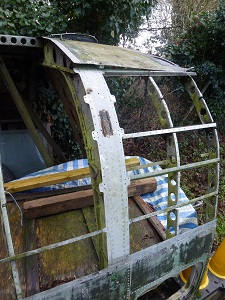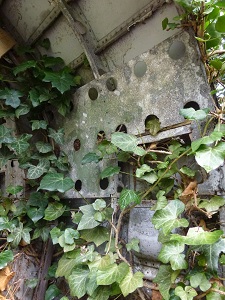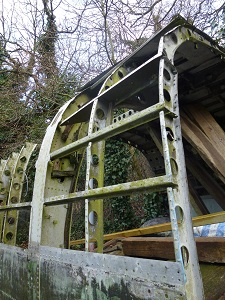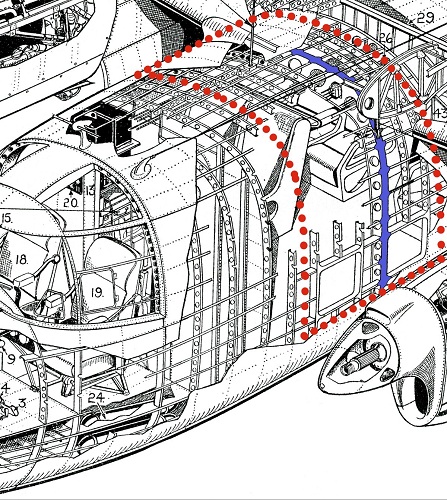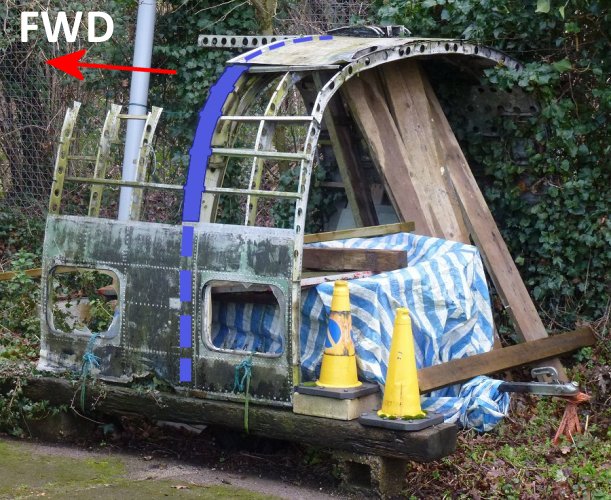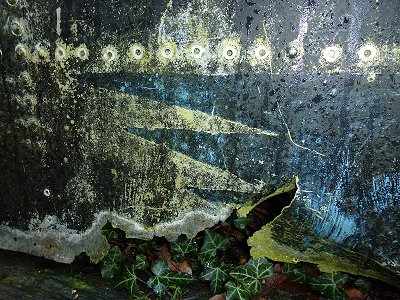Above is a view of the area where the markings are visible. I have outlined the window and markings in red to clarify their relative positions. Finally (below) are comparative views of the same area on all three of Derby Airways' Marathons. It can be seen that the 'tail' of the letter 'A' on G-AMEW is too far forward, being level fore-and-aft with the rear edge of the window, though of similar style. The tail of the 'A' on G-AMHR is too far aft and of a different style. For me, the tail of the 'A' on G-AMGW is in the right position and of the right style. It's a pretty close match - certainly closer than the other two. Thus, my considered opinion is that the Museum's fuselage isn't from G-AMEW, but from G-AMGW.
I'd appreciate comments on this.

The histories of the three aircraft are as follows (data courtesy of Peter Amos):
c/n 118 M.60 Mk.1. Registered G-AMEW 28Sep50 to Handley Page (Reading) Ltd, Woodley. CofA No.A.2944 issued 29Jun51. Stored at Woodley. Cancelled 21Sep51 and registered 02Oct51 to the Minister of Supply. Transferred to RAF charge 28Mar52 for conversion to Marathon 103 T.Mk.11. Cancelled 13Jun52, transferred to military. Sold to RAF 13Jun52 and given s/n XA265. Conversion took place from 08Jul53 to 29Jan54. Retained by Handley Page (Reading) Ltd for development and trial installations, etc, from 19Feb54. Transferred to Handley Page (Reading) Ltd 02Oct54 and used for cabin heating tests from 10Nov55 to 19Oct56. Registered G-AMEW 16Aug57 to Derby Aviation Ltd. Flown from Woodley to Burnaston 28Aug57. CofA renewed 02Jul58 and into service 07Jul58. Last commercial flight 26Sep60. Withdrawn from service 27Sep60. Scrapped at Burnaston in 1962. Cancelled 17Feb64 'destroyed'.
c/n 127 M.60 Mk.1A. Registered G-AMGW 29Dec50 to Handley Page (Reading) Ltd, Woodley. Intended for BEAC and named 'Clansman' but not delivered. CofA No.A.3105 issued 10Sep51. Stored at Woodley. Cancelled 13Nov51 & registered 04Dec51 to the Minister of Supply. Cancelled 09Jul52 & registered 21Jul52 to West African Airways Corporation. CofA renewed 18Aug52. Deld via Heathrow 28Aug52. Cancelled 03Sep52, transferred to Nigerian register as VR-NAN in Nov52. Named 'Lagos'. Withdrawn from service and Nigerian registration cancelled early 1954. Ferried to Cranfield for storage by 01May54. Flown to Lasham for storage 09Jun54. Flown to Cranfield for further storage 10Mar55. Sold by Shackleton Aviation Ltd to Derby Aviation Ltd. Regd G-AMGW 11Oct55. Named 'Millersdale', and into service 27Mar56. CofA renewed 27Mar57. Withdrawn from service 25Jul60. Scrapped at Burnaston Dec60, but engineless fuselage still there Aug61. Cancelled 17Feb64 'destroyed'.

G-AMHR derelict at Burnaston, circa 1962 (AI Topps via Peter Amos)
c/n 129 M.60 Mk.1A. Registered G-AMHR 02Mar51 to Handley Page (Reading) Ltd, Woodley. Intended for BEAC and named 'MacDonald' but not delivered. CofA No.A.3180 issued 21Sep51. Stored at Woodley. Cancelled 18Sep51 & registered 25Oct51 to the Minister of Supply. Cancelled 09Jul52 & registered 21Jul52 to West African Airways Corporation. CofA renewed 21Sep52. Delivered via Blackbushe in Oct52. Cancelled 22Oct52, transferred to Nigerian register as VR-NAR in Dec52. Named 'Kumasi'. Withdrawn from service and Nigerian registration cancelled early 1954. Ferried to Cranfield for storage by 01May54. Flown to Lasham for further storage 05Jun54. Flown to Woodley 10Mar55. To Cranfield for further storage 11Mar55. Sold by Shackleton Aviation Ltd to Derby Aviation Ltd. Registered G-AMHR 11Oct55 to Derby Aviation Ltd. CofA renewed 13Jul56. Named 'Monsaldale', and into service 13Jul56. Last commercial flight 18Jul60 and then withdrawn from service. Scrapped at Burnaston Dec60, but engineless airframe still there Aug61. Cancelled 17Feb64 'destroyed'.
The Solution
Following a couple of emails to Miles guru Peter Amos, Peter unearthed some documentation that confirmed my suspicions: the fuselage section at the Museum is indeed from G-AMGW. Not only that, but he also attached a photo of the section being cut from this aircraft. I think it makes for an even more initeresting story, for G-AMGW was an aircraft planned for BEA service (though never achieved) and not only saw service in Africa, but was also the first of the Derby Airways Marathons to enter service.
The documents that Peter uncovered detail the story of how this fuselage section came to be separated from the rest of the aircraft by Derby employee Anthony I 'Tony' Topps. This is how Tony recalled it becoming a caravan and then a chicken shed,
"I wanted to make something better than a camping trailer, more like a miniature caravan to tow behind my Hillman Minx. I measured up the fuselage and thought it had possibilities.
Our Chief at the time was Ron Paine, TD. I asked him if I could have a slice of 'Golf Whiskey's fuselage. He said yes and never asked why. He probably did not realize the size of the slice. The cutting-out was by hacksaw, fire axe and shears, I was Deputy Chief Inspector and really knew my way around the Marathon.
I transported it (the slice) by the Company Bedford truck to my father-in-law's orchard ar Elsted Farm in the village of Blackfordby. The farm and orchard are no more. It is now a housing estate.
I proceeded to work and design as I went along. Basically it was trimmed up, mounted on angle iron chassis with slotted angle front and rear. Wooden planks for the floor, 1 inch by 2 side frames covered with hardboard, all edges sealed with aircraft 4 inch tape and doped. The whole unit was mounted on an Austin Seven axle and springs. All the pulleys and brackets etc were left in situ, the object being for it to be seen as part of an aeroplane for the novelty of it. Problem - the weight went up and could only be handled with difficulty. This defeated the whole object.
The outcome was that the late father-in-law, Mr E Bailey, asked if he could use it for his hens. That was its use until the local ATC took possession."
Tony had one other revelation concerning G-AMGW during its flying days with Derby Airways,
"One passenger of note in 'GW was Cliff Richard. He had his car stolen while doing a show at Derby. He chartered 'GW on 1st May 1960 to get him to his next show at Carlisle. They landed at RAF Silloth."
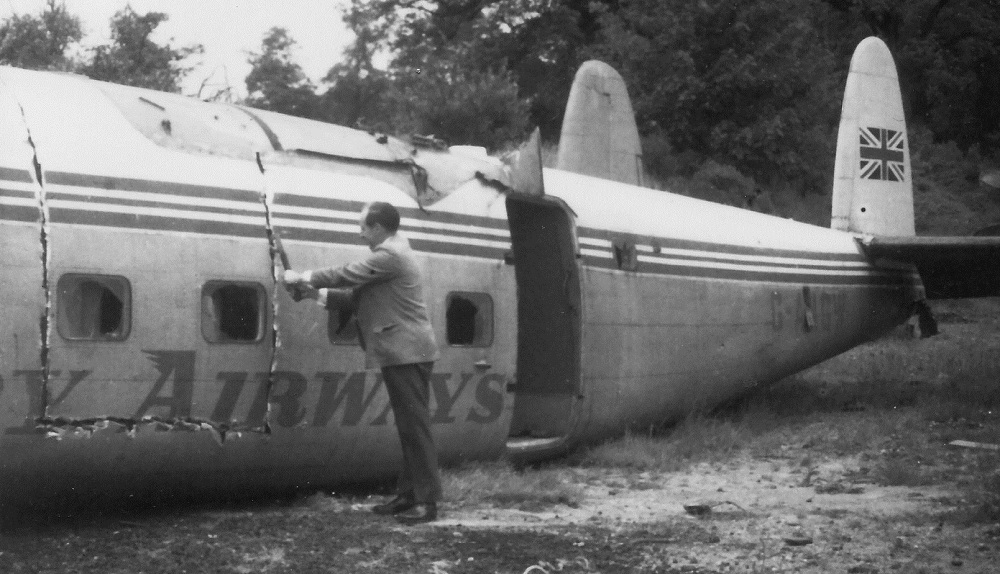
The Museum of Berkshire Aviation's fuselage section about to be cut from G-AMGW at Burnaston. To quote Tony Topps, "The man you see with the fire axe was my friend and work colleague, the late Frank Marshall. He was Engineering/Operations Manager at the time. He asked if he could have a go, something he had wanted to do for a long time. I know the feeling well. They did create a lot of work through defects, cracks etc. Frank had come through a full tour of operations as Flight Engineer on Stirlings and they were his strength standard/criteria" (AI Topps via Peter Amos)
Home

